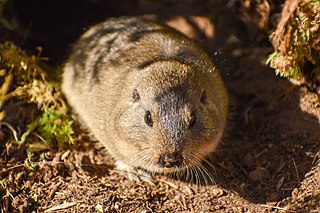Pearson's chaco mouse is a species of rodent in the family Cricetidae. This mouse is found in the Gran Chaco ecoregion of southeastern Bolivia and western Paraguay at elevations up to 400 m. The species is named after American zoologist Oliver Payne Pearson. Its karyotype has 2n = 76 and 78 in the two subspecies. The latter is the highest diploid number of any species in the tribe Phyllotini.
Colburn's tuco-tuco is a species of rodent in the family Ctenomyidae. It is known only from Argentina.
Conover's tuco-tuco is a species of rodent in the family Ctenomyidae. It is found in Argentina, Bolivia, and Paraguay.
The reddish tuco-tuco is a species of rodent in the family Ctenomyidae. Five subspecies have been recognized, some formerly designated as separate species. It is found in Argentina and Bolivia at altitudes from 600 to 4,500. This tuco-tuco is fossorial, like others in its genus. Its diet consists of underground tubers and roots. Its karyotype has 2n = 52 and FN = 78.

The silky tuco-tuco is a species of rodent in the family Ctenomyidae. It is endemic to Argentina.
Steinbach's tuco-tuco is a species of rodent in the family Ctenomyidae. It is endemic to Bolivia. The species is named after zoological collector Dr. José Steinbach (1856–1929).
The robust tuco-tuco is a species of rodent in the family Ctenomyidae. It is a burrowing rodent and is endemic to the Tucumán Province of Argentina.
Berg's tuco-tuco is a species of rodent in the family Ctenomyidae, named after the Latvian-Argentine biologist Frederico Guillermo Carlos Berg. It is endemic to northwestern Córdoba Province in central Argentina. Its habitat is grassy areas overlying sand dunes. The species is threatened by the degradation and severe fragmentation of its small habitat.
Budin's tuco-tuco was formerly considered a species of rodent in the family Ctenomyidae. It is endemic to southeast Jujuy Province in northwest Argentina. Given the extensive human presence in its limited range, it has been suspected to be threatened. The IUCN currently views it as a subspecies of C. frater. It was named after Emilio Budin, an Argentine specimen collector who worked with Oldfield Thomas.
The Puntilla tuco-tuco is a species of rodent in the family Ctenomyidae. It is endemic to central Argentina. The common name of the species comes from the municipality of La Puntilla at the type locality. It was first described by the British zoologist Oldfield Thomas in 1920 after being collected by Emilio Budin, an Argentine specimen collector who worked with Oldfield Thomas.

D'Orbigny's tuco-tuco is a species of rodent in the family Ctenomyidae, named after French naturalist Alcide d'Orbigny. It is found in northeast Argentina. Its karyotype has 2n = 70, FN = 84–88, which is cytogenetically indistinguishable from some populations of C. pearsoni; the latter taxon may actually represent several species.
Foch's tuco-tuco is a species of rodent in the family Ctenomyidae. It is endemic to northwestern Argentina, where it is known from southwestern Catamarca Province. The species is named after World War I general Ferdinand Foch.
The Lago Blanco tuco-tuco is a species of rodent in the family Ctenomyidae. It is known only from the Lago Blanco area in southern Argentina. Its karyotype has 2n = 28 and FN = 42.

Flamarion's tuco-tuco or the tuco-tuco of the dunes is a rodent species of the family Ctenomyidae Its karyotype has 2n = 48 and FN = 50–78. found in coastal dunes of Rio Grande do Sul state, southern Brazil. The species is threatened by habitat loss due to dune removal and urbanization. It is named after Brazilian biologist Luiz Flamarion B. de Oliveira.
Goodfellow's tuco-tuco is a species of rodent in the family Ctenomyidae. It is endemic to Bolivia, where it is found in the Chiquitano dry forest ecoregion, bordering on the cerrado. Its karyotype has 2n = 46 and FN = 68. The species is named after British collector Walter Goodfellow.
The Pilar tuco-tuco is a species of rodent in the family Ctenomyidae. It is found in Ñeembucú and Misiones Departments in southern Paraguay, east of the city of Pilar. The species lives in areas with sandy soil. It is present in a few isolated populations and is threatened by conversion of its habitat to agriculture and its treatment as a pest. Its karyotype has 2n = 48 or 50 and FN = 50.
Pundt's tuco-tuco is a species of rodent in the family Ctenomyidae. It is endemic to the Pampas of southern Córdoba and San Luis Provinces in central Argentina. The species is named after Argentine landowner and collector Moritz Pundt. It has a fragmented population and is threatened by conversion of its habitat to agricultural use.
Roig's tuco-tuco is a species of rodent in the family Ctenomyidae. It is endemic to a small region near the Paraná River in Corrientes Province, northeastern Argentina, where lives on sand dunes, and near rivers. Development is degrading and shrinking this habitat, threatening the rodent's survival. The species is named after Argentine zoologist Virgilio G. Roig. Its karyotype has 2n = 48 and FN = 80.
Scaglia's tuco-tuco is a species of rodent in the family Ctenomyidae. It is endemic to a locality in Tucumán Province, northern Argentina. The species is named after Argentine naturalist Galileo Juan Scaglia (1915–1989). Its karyotype has 2n = 36 and FN = 64.
Yolanda's tuco-tuco is a species of rodent in the family Ctenomyidae. The species is endemic to Santa Fe Province, northeast Argentina, where it lives near the Paraná and San Javier rivers. Its karyotype has 2n = 50 and FN = 78. It is named after Argentine biologist Yolanda Davis.




